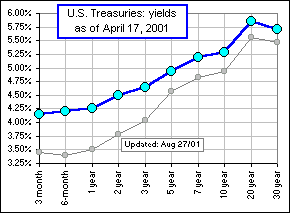| Bonds IV and bond ladders: a continuation of Part III |
Here we consider Bond Ladders where we ...
>Ladders? With rungs and ...?
Rungs, yes. Pay attention. Here's what we do:
- Today is January 1 and we buy three bonds.
- The first matures 1 year from today, the second in 2 years, the third in 3 years.
- The maturity dates are the rungs of the ladder.
- At the first maturity date (one year from now) a bond matures and we immediately
buy a 3-year bond
(recognizing that the yield may change for this new bond). - At the next maturity date we buy another 3-year bond.
- etc. etc.
- On January 1 of each year we always have three bonds maturing in 1, 2 and 3 years (with, usually, different yields).
Remember the formula for the Value of our bond purchases 
(For simplicity, we'll assume zero coupon bonds.) Suppose we spend equal amounts on our three bonds (meaning equal V-values).
|
|
One year from now, we cash in the first bond for $B1, re-invest in a 3-year
bond at a yield of R4.
the maturity value is B1(1+R4)3 =
V(1+R1)(1+R4)3.
The year after that, we cash in a bond for $B2, re-invest in a 3-year
bond at a yield of R5:
the maturity value is B2(1+R5)3 =
V(1+R2)2(1+R4)3.
The year after that, we cash in a bond, get $B3, we re-invest in a 3-year ...
>Can't you just make a table? I mean ...
Okay, but to make things simpler, let's define the Gain Factors
G1 = (1+R1), G2 = (1+R2), etc. etc.
| Do you see how things are progressing?
>No. The Cash Values keep getting multiplied by a (Gain Factor)3 ... with a possibly different yield. That becomes the Maturity Value. That Maturity Value reappears 3 years later (when it matures) as a Cash Value, then it gets multiplied by ... >A (Gain Factor)3? Exactly. >So? So, our goal is to see how the value of our bond portfolio grows. And how our annualized return depends upon the sequence of yields. And whether we should buy 4 or maybe 6 or 10 bonds with increasing maturities. And what kind of average yield ... >So just do it. |
|
Okay, suppose ... >Wait! What of we buy bonds with coupons? Then what? Then we change the Gain Factors from G to something that includes the Coupon Rate and ... >What's that? Have you forgotten already? 
We've used V = B/G with 1/G = 1/(1+R). If we include coupons we'd use: 1/G = {1/(1+R)N + (Cr/R) (1 - (1+R/m)-mN)} |
|
|
>You don't have any pictures.
Notice that, except for initial transients, the gains are associated with the longest term bonds ... because of the G3 factors which keep piling up, in Table 1. Hence, although we always have bonds maturing in 1, 2 and 3 years, our gains are more and more associated with the longest term bonds. >Is that good?
| 
|
>If, eventually, the gains are associated with long term bonds, then ...
Then why not just buy long term bonds? Yes, but our objective is to have staggered
maturities ... so we have to start with short and long term bonds. As each matures,
we buy the longer bonds.
>Yeah, but if I like 5-year bonds then I'd just buy a 5-year bond.
Then, when it matures, you buy another 5-year?
>Why not?
|
What if yields are really high or really low when it comes time to buy another bond? What if ...?
>If I'm afraid of volatility in interest rates, then I'd buy 5-year bonds
that mature in 1-year, 2-years ... uh ...
>I buy 5-years.
>Does that really lower volatility?
| 
|
One-of-these-days I'll have a spreadsheet which looks like this.
 for Part V on Bond Convexity.
for Part V on Bond Convexity.

